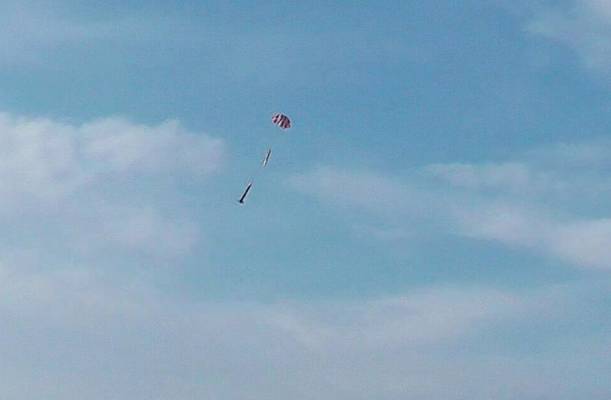The Aero-Hi: This is a cute little flier from Estes using 13mm T engines. It is a pseudo-scale sounding rocket design. This normally uses a tiny 8-inch parachute but was converted to a streamer for a bit, then later converted back into a parachute recovery which I find easier to pack. I actually have two of these, one painted green and this one red. One unique feature of this kit is the simulated conduit up the side of the body tube, made from a balsa strip.
This rocket was later given my "Iris" modification, which extends the body tube about 5 inches above the streamer/parachute bay, and allows for a payload with an Altimeter One or Two to measure altitudes. It's a shame I "ruined" it by adding the payload, she was a cute little bird. (I can always remove the payload.) I like to send this, or the EAC Viper rocket up first on launch days, it's a good and economical way to get an idea how the winds are blowing without risking a lost rocket. As a result, this has flown many times. (Iris is named after the Greek god of the rainbow. She is a messenger of the gods, linking the gods with humanity.) This rocket has flown as high as 282 feet with the A motor, which is higher than the Cape Hatteras Lighthouse in NC, the tallest lighthouse in the USA.
| Flight Date: | 2012-12-02 |
| Rocket Name: | Aero-Hi |
| Kit Name: | Estes - Aero-Hi {Kit} (817) [1973-1974] |
| Flyer's Name: | Rich DeAngelis |
| Motors: | 1/2A3-2 |
| Expected Altitude: | 100 Feet |
| Wind Speed: | 7.00 mph |
| Launch Site: | Penn Manor School Lancaster PA |
| Actual Altitude: | 96 Feet |
I started today with the Aero-Hi. The wind prediction for stronger winds fortunately did not come to pass, and the sky was mostly clear and in the 50’s (great for December). I followed thru with my “windy” flight schedule for today anyway, since I didn’t bring my other high-altitude rockets. At the top of the list was the Aero Hi with the 1/2A motor.
This was my first test flight with the 1/2A motor for any rocket, although I used these motors back in the 1970s. I had just removed 3.3 grams of nose weight on the Aero-Hi, which was left over from when this model didn’t have the 5.8 grams of additional payload.
The 1/2A engine burned for 4/10 seconds, peaking the acceleration at 10.3 Gs and getting this rocket to a speed of 45 mph. It then coasted for 2.2 seconds to reach an apogee of 96 feet. After turning over and falling 14 feet in the next 9/10 seconds, the parachute deployed only 1/10 second later than spec’d. From 88 feet the rocket coasted back to earth at 11 mph with a good parachute, landing about 40 feet downwind. This was a very good flight, lasting a mere 8.8 seconds.
| Stage | Motor(s) |
|---|---|
| 1 | Estes 1/2A3T-2 |
 |
 |

